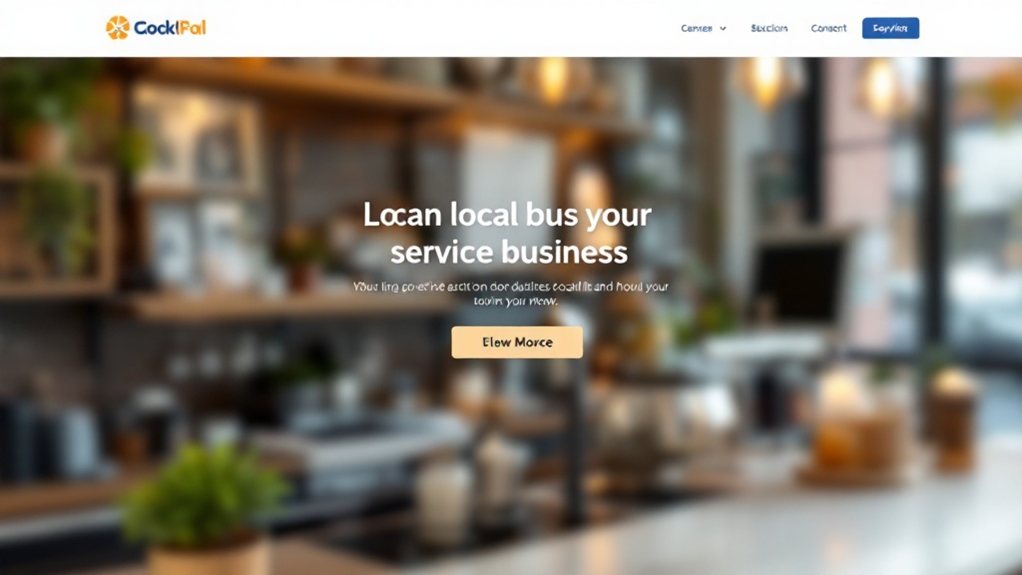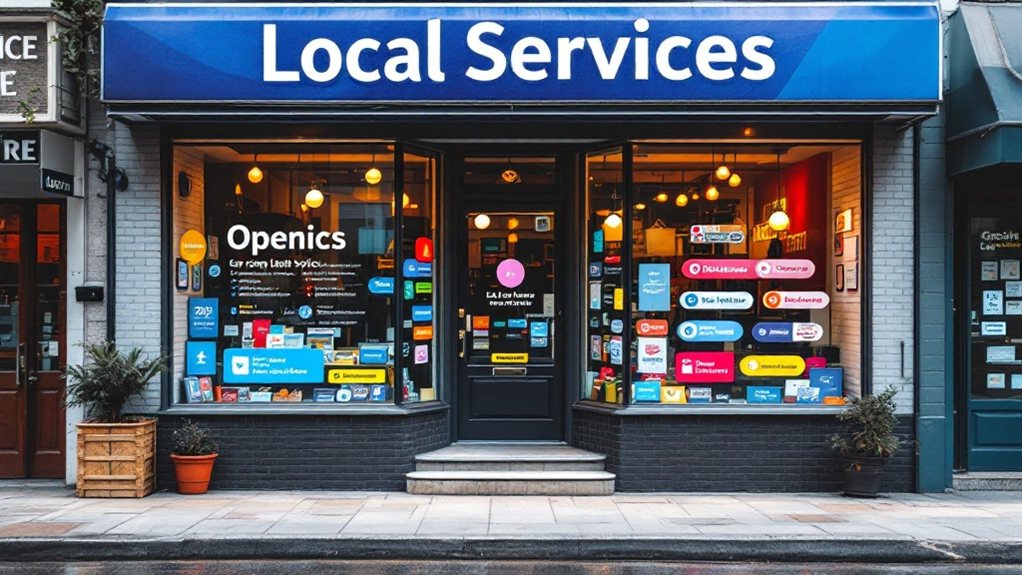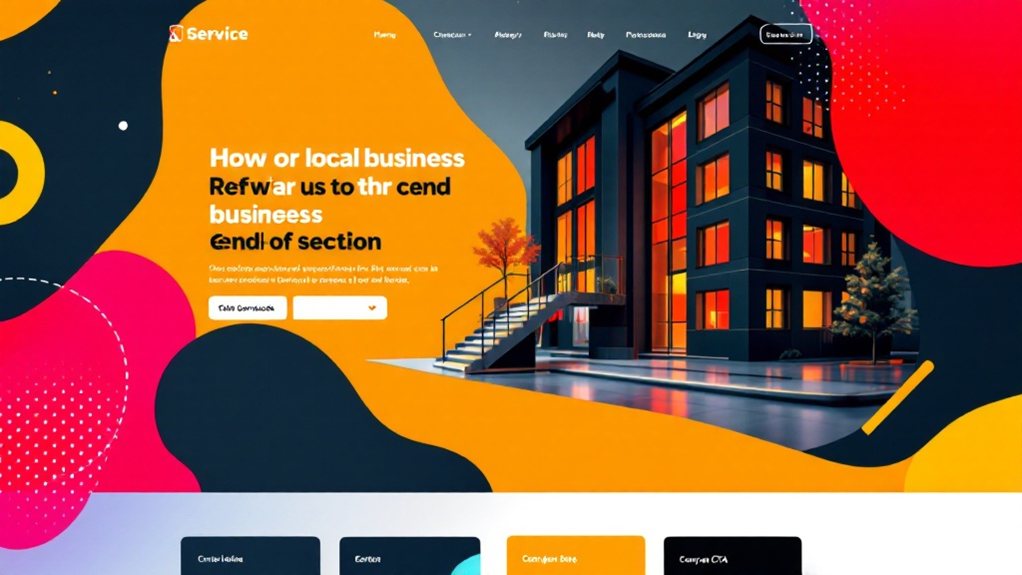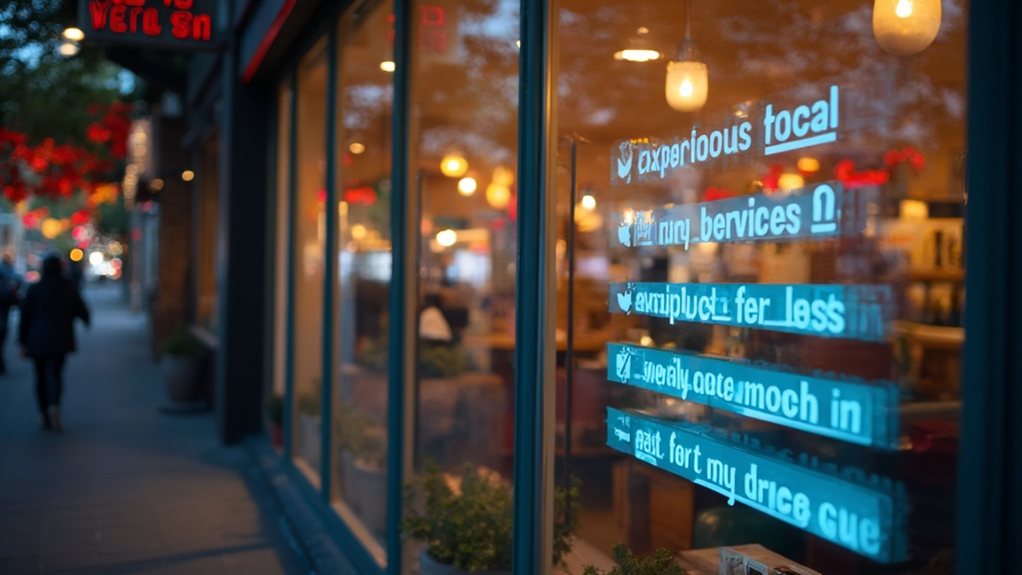As a local business, you'll want to strategically place call-to-action (CTA) buttons throughout your service pages to guide potential customers. Position CTAs prominently above the fold to capture initial attention. Embed them within your content to seamlessly guide the user journey. Place CTAs at the end of sections to prompt immediate action. And use exit-intent popups to recapture visitors about to leave. By optimizing your CTA strategy, you'll see improved engagement and conversions. Keep reading to dive deeper into enhancing your local business CTA approach.
Enhancing Visibility With Above-The-Fold CTA Placement

Although content above the fold is crucial for initial user engagement, simply placing your call-to-action (CTA) in this prime real estate isn't enough. To truly enhance visibility, your CTA must be strategically designed and positioned. Eye-tracking studies show a significant drop-off in user attention below the fold, making above-the-fold content more likely to be seen. Furthermore, Google's research indicates that ads above the fold have a 73% viewability rate compared to 44% below. By placing your CTA prominently above the fold, you can effectively capture user attention and guide them toward your desired action, especially beneficial for B2C businesses seeking quick conversions. Above-the-fold CTAs align with customer journey for quick sales, which further emphasizes their importance.
Embedding CTAS Within Content Flows for Higher Engagement

Embedding CTAs within your content flow can significantly boost user engagement. By strategically positioning calls-to-action throughout your service pages, you can guide users seamlessly through your content and encourage desired actions. Adopt a natural progression, ensuring CTAs feel like a logical extension of the narrative. Leverage contextual relevance by placing CTAs at points where they align with user needs and interest. Regularly test different CTA variations to uncover the most effective phrasing, placement, and design. This enhanced user experience, combined with data-driven insights, can drive higher conversion rates. Craft compelling CTAs using clear, action-oriented language that resonates with your audience and creates a sense of urgency. Personalized CTAs perform 202% better than basic CTAs. Continuously optimize your CTA strategy based on user feedback and performance data to maximize engagement and conversions.
Prompting Action With End-Of-Section CTA Positioning

Strategically positioning CTAs at the end of content sections can effectively prompt user action. By leveraging the momentum from engaging content, you can encourage higher click-through rates and boost conversions. Place CTAs where users are most receptive, such as the conclusion of a section, to capture their attention when they're ready to act. Placing CTAs at the end of sections can effectively trigger immediate responses from engaged users.
| Positioning | Benefit | Consideration | Impact |
|---|---|---|---|
| End of Section | Captures engaged users | Ensure smooth content flow | Increased Conversions |
| Within Content | Guides user journey | Maintain balance with copy | Better Engagement |
| Above the Fold | Immediate visibility | Avoid interrupting user experience | Higher Clickthrough |
Optimizing CTA placement based on user behavior and A/B testing will ensure your local business service pages effectively prompt the desired actions.
Leveraging Sidebar CTAs for Secondary Conversions
Positioning CTAs in the sidebar of your local business service pages can be an effective way to capture secondary conversions. By leveraging contrasting colors and strategic placement, you can make these CTAs visible without distracting from your primary call-to-action. Secondary CTAs provide alternative paths for engagement and offer lower-commitment options, reducing friction and encouraging engagement from users not yet ready for the main offer. Proper optimization and A/B testing can boost your overall conversion rates by as much as 25%. Analyzing the performance of these secondary CTAs is crucial, as they can support lead nurturing and build diverse engagement paths, complementing your primary conversion goals.
Recapturing Attention With Exit-Intent Popup CTAS
When visitors show signs of leaving your local business website, exit-intent popups provide a powerful way to recapture their attention and encourage further engagement. By triggering the popup at the right moment, you can offer a clear and compelling call-to-action that creates a sense of urgency and value. A simple, visually-appealing design with minimal text ensures the offer stands out and doesn't overwhelm. Customizing the popup to target specific user behaviors or segments enhances its relevance, leading to increased conversion rates, reduced cart abandonment, and more valuable lead generation. Exit-intent popups are designed to grab visitors' attention just as they are about to leave a website. Tailoring the popup with local offers, geographic targeting, and exclusive discounts further resonates with your audience, maximizing its impact on your bottom line.
Personalizing CTA Copy to Appeal to Target Audiences
Personalizing CTA copy to appeal to your target audiences is a powerful way to boost engagement and drive conversions. By leveraging data-driven insights, you can craft CTAs that speak directly to your visitors' needs and intentions. Utilize specific, action-oriented language and address their unique pain points. Align your CTAs with the relevant content to ensure contextual relevance. Experiment with dynamic elements like social proof and urgency to enhance their effectiveness. Implement personalized CTAs across your website, email, and paid channels for a consistent, tailored experience. Personalized CTAs can help local businesses better connect with their target audiences. The benefits are clear – improved conversion rates, increased engagement, and stronger customer relationships. Embrace the power of personalization to optimize your CTA performance.
Utilizing Attention-Grabbing Words for Impactful CTAs
Crafting attention-grabbing CTAs starts with leveraging powerful words that inspire immediate action. Action verbs like "buy," "subscribe," and "join" create momentum and prompt engagement. Phrases that evoke urgency, such as "Act now" or "Limited stock," increase conversions by prompting faster decision-making. Emotional triggers like "instant access" or "exclusive offers" also enhance CTA effectiveness by tapping into your audience's goals and priorities. When aligning CTAs with your local business, focus on immediate actions like "Call now" or "Get a quote" to generate leads. CTAs play a crucial role in guiding website visitors through the customer journey. Ultimately, concise, straightforward language that highlights the benefits is the key to making your CTAs impactful.
Designing Visually Appealing Button-Based CTAs
Visually appealing button-based CTAs go beyond compelling language – they captivate users through strategic design. Focus on these key elements:
- Size and Placement: Larger buttons boost click-through, but balance aesthetics. Position them to align with user reading patterns.
- Visual Hierarchy: Use size and contrast to make buttons stand out.
- Interactivity: Add hover effects or animations to enhance engagement.
Ensure your CTAs meet accessibility standards with sufficient color contrast and white space. Leverage urgency messaging, social proof, and clear calls-to-action to drive conversions. By optimizing your button-based CTAs for both design and engagement, you'll create a compelling user experience that boosts your local business service offerings.
Optimizing CTA Colors for Maximum Contrast and Visibility
While visually appealing CTAs require strategic design, optimizing the colors is crucial for maximizing contrast and visibility. Choose colors that stand out from the page's dominant shades, creating a strong visual cue that encourages user action. High-contrast colors like red, green, and blue evoke specific emotions, influencing user decisions. Continuously testing CTA colors can determine the most effective combinations for your target audience, considering cultural associations. Additionally, ensure the button size, placement, and background complement the CTA for optimal visibility, especially on mobile devices. Proper color contrast can increase sales by over 35%, making it a critical element in designing successful CTAs for your local business service pages.
A/B Testing CTA Designs for Continuous Improvement
Continuously improving your call-to-action (CTA) designs through A/B testing is crucial for maximizing user engagement and conversions on your local business service pages. By tracking metrics like click rates and conversion rates, you can make data-driven decisions to optimize your CTAs. Remember:
- Testing one element at a time (e.g., color, font type, icon) helps in isolating what improves performance.
- Ensuring CTA consistency across all devices and browsers is crucial for effective testing.
- Regular monitoring and refinement of CTAs are key to maintaining improved conversion rates over time.
- Analyzing A/B test results lets you pinpoint which CTAs drive the best outcomes for your business.
Incorporating A/B testing into your marketing strategy promotes continuous improvement and better user engagement on your local business service pages.
